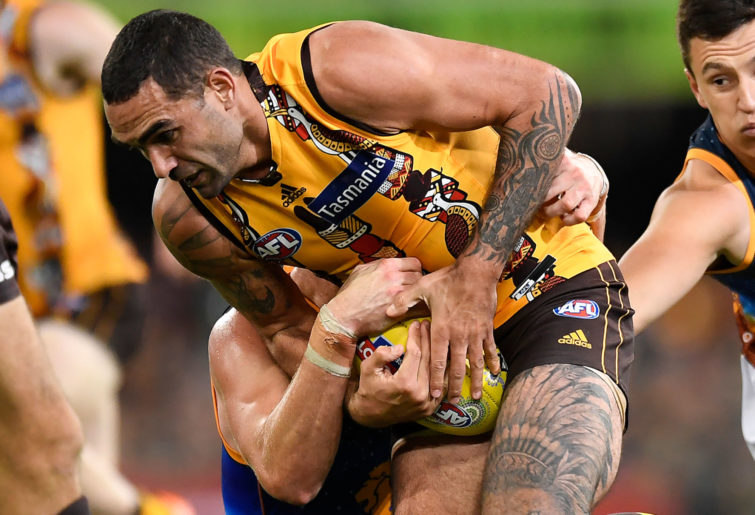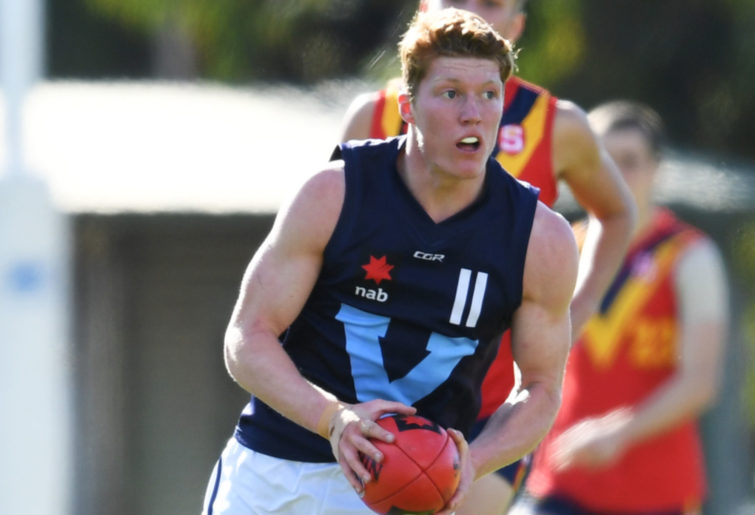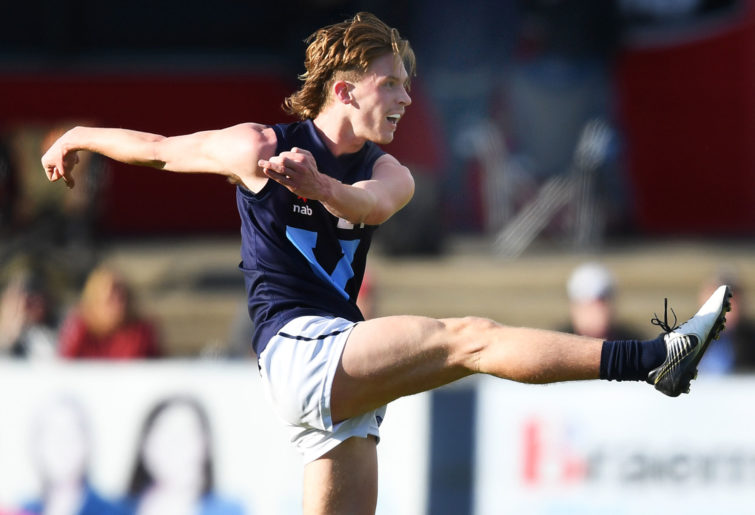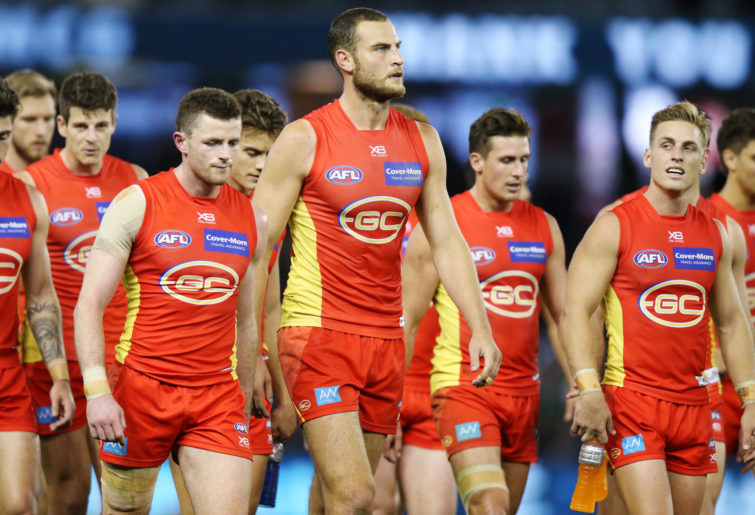Observable across the entirety of the league is that trading has a quicker impact on a team’s fortunes than drafting does.
For example, if you invest 1000 DVI points in the 2014 draft, you could expect an average return from that of about 70 AFL games and 22 AFLCA votes over the last five years.
Put that same investment into a trade in 2014 and you’ll get a bigger impact – an average output of 100 AFL Games and 61 AFLCA votes.
The other side of the coin, of course, is that drafting is likely to be a better investment over the longer period, if you’re willing to be patient. AFL clubs generally aren’t – the average proportion of DVI capital spent on trades has increased (non-linearly) from 24 per cent to 31 from 2014 to 2018.
Gold Coast’s numbers here are a similar story to that of their drafting. They’ve been able to make a larger investment than most clubs, and are getting a good return in terms of games played, but not when it comes to quality of performances.
The Suns’ trade-ins from 2014 onwards have amassed just barely half the league average of AFLCA votes during this period of time.
No other club has spent so much to achieve so little – Carlton, who’ve spent around 5000 DVI points on trades for a return of 81 votes, are the closest.
How each side drafts and trades will, of course, shape the overall profile of their list, and the outcomes of this tell us a lot about where the club is at and what expectations it’s reasonable to have of them.
The chart below shows three age brackets – youth (18-22), prime (23-27), and veterans (28+). We’ll look at how many players each club has in each category, and then can also see where clubs decided to invest AFL game experience this year and the outcome in terms of AFLCA votes they were rewarded with.
| Gold Coast Suns list profile |
| Age |
Players |
Games |
% of total |
Votes |
% of total |
| 18-22 |
28 |
236 |
51.1% |
52 |
42.3% |
| 23-27 |
17 |
185 |
40.0% |
63 |
51.2% |
| 28+ |
3 |
41 |
8.9% |
8 |
6.5% |
| Total |
48 |
462 |
– |
123 |
– |
Given their drafting and trading over the past five years it’s no surprise that Gold Coast have an abundant amount of young players on the list, and are marking a significant games investment into them.
Carlton are the only club with more players in the 18-22 bracket on their playing list, and no other team in the league pumped more games into this age group in 2019 than Gold Coast.
This age bracket is producing a below-average number of AFLCA votes for the Suns, but that’s not surprising, for the reasons we’ve already discussed. They’re at least reasonably close to the average which is about 57.
More problematic is the lack of contribution coming from players in the prime and veteran age bracket. They’ve had 63 votes from players 23-27 this year compared to a league average of 180, and just eight votes from players 28+ when the league averaging 72.
“Get better senior players” is therefore unsurprisingly the obvious path for Gold Coast to go down, but the big question is – and it’s one they’ve struggled with for years – how?
Under or over?
Our last piece of analysis for each club on the stats, here we’ll take a quick look at what kind of 22 they were able to put out on the field each week, and how that informs our judgment of their 2019 performance.
Thanks to Stats Insider for providing the age and experience data that makes this section possible – I highly recommend their AFL prediction and shot charting tools, if you haven’t seen them already.
Gold Coast, as you might expect, were at the bottom of the table this year for both the average age (23.9 years) and games experience (70.5 matches) of their average playing side.
They fielded a younger side than their opponents in all 22 games, and only held a more experienced side than their opponents once all season – against Essendon a few weeks ago, when they nearly caused what would’ve been seen as an upset.
These stats do matter, without necessarily being a bible. This season’s results show that the team ahead on age and/or experience wins about six out of ten games.
The reverse of that says a younger or inexperienced side should get up about 40 per cent of the time, a mark that Gold Coast clearly fall well below.
Especially concerning is that all three of their wins were by margins of less than a goal. Break a few more mirrors in the preseason and this club could easily have gone 0-22.
Gold Coast’s saving grace is that – and this is not an uncommon theme for them – their year was significantly hampered by injury.
To quantify this I’ve created the Experience Utilisation Rate which shows the percentage of games experience on the list each club was able to put on the field on average across the season.
As if having one of the league’s least experienced lists wasn’t bad enough, the Suns also suffered an EUR of 61.3 per cent, the third-worst in the league and well below the 67.2 per cent average.
Verdict: About fair. Gold Coast’s performances this year weren’t great, but if you look at the barriers that stood between them and competitive footy, they did about as well as one could reasonably expect.

(Photo by Michael Dodge/Getty Images)
Contract watch
Rather than a complete contract list as I’ve done in previous years, in this section we’ll take a quick look at those players each club has out of contract.
We’ll also take a squiz at – if there are any – those who will be free agents next year, or ‘pre-agents’, as Ryan Buckland would call them, given the trend towards trading these players early that’s developed recently.
Out of contract
Callum Ah Chee, Brayden Crossley, Jacob Dawson, Sam Fletcher, Jacob Heron, Nick Holman, Jack Leslie, Jack Martin, Tom Nicholls, Connor Nutting, Mitch Riordan, Brad Scheer, Harrison Wigg
The obvious name drawing attention here is Jack Martin, who seems likely to seek a move away from the club via trade – we’ll discuss that more soon enough.
But two who have flown under the radar are a former top-ten draft pick in Callum Ah Chee and ruckman Tom Nicholls. Expect Nicholls to look for a new home if possible, while Ah Chee remains something of an enigma.
Of the remaining names, Nick Holman is one who you’d assume will be retained without too much question, while the club faces a more difficult decision on Brayden Crossley, who is facing a lengthy suspension.
Pre-agents
Jarrod Harbrow
Nothing to see here. If Harbrow had any plans to leave the club he’d have done so a while ago.
Free agency
Holman and Nicholls are both free agents at the Suns this year as are Jack Leslie, Brad Scheer and Harrison Wigg. None of them look likely to attract anything in the way of significant compensation if they do.
Where Gold Coast appear more likely to make headlines in the free agency space this year is with their pursuit of Fremantle veteran Stephen Hill.
There’s a strong argument to make for Gold Coast pursuing Hill – their list profile shows a clear need to add senior players, and Hill, being an outside-leaning player, would provide a point of difference to the more nuggety types they’ve acquired in recent years.
The reason Gold Coast are a serious chance to get someone like Hill on the list is the same reason however that they should arguably be a bit cautious of him – he has spent the 2019 season struggling with injury.
Hill has played just three games this year and a lukewarm 34 across the past three seasons. At 29 years of age, it’s debatable whether he’ll be able to return to peak fitness.
There’s a significant risk the Suns would add him to their list only to find that they cannot get him on the park, further disrupting the development of a side that already struggles to gain a consistent output from their older players.
If the Suns want to look for players who have a bit more in the way of proven durability, there’s a few options.
The obvious one and someone they’ve already been linked to is Shaun Burgoyne. The four-time premiership player was reportedly approached by Gold Coast earlier in the year about a two-year contract that would help him break the 400 game barrier.

(Photo by Albert Perez/Getty Images)
Burgoyne would be a perfect fit at Gold Coast – someone with experience of success, elite professionalism, and a huge on-field and off-field presence. The players would hang on his every word.
Unfortunately for Gold Coast, it seems more likely that he’ll decide to sign a one-year deal with Hawthorn for 2020.
Other options to potentially pursue in the free agency space would be Justin Westhoff, David Mackay, and Levi Casboult, though the last of these may have activated a trigger extension for 2020.
Looking more at a ‘prime-age’ player rather than a valuable vet, Brandon Ellis is one who could be a valuable contributor at the club.
Uncertain of a spot in the best 22 at Richmond and with a premiership already under his belt, Ellis might potentially be sway to come to the Suns and mentor younger players – especially if there’s a big pay packet included in the deal.
Trade period
No strangers to speculation about their uncontracted players, Gold Coast have had to endure public interest in Jack Martin all season long.
Martin asked the club for a trade to Essendon at the end of last year, but was given a firm no while still contracted for the 2019 season to come.
Throughout the year there’s been some talk coming out of the Suns that they believe Martin could be convinced to stay and commit to the side longterm. And it might not be totally off the table just yet.
Still, after being dropped to the NEAFL late in the season and not returning to the senior side, you’d have to expect the most likely result is Martin again asks for a move, and the Suns won’t be able to deny him this time.
It won’t be Essendon this time around. The Bombers spent big to secure Dylan Shiel last offseason and simply don’t have the room to accommodate another star recruit.
Instead, Carlton are probably the club who have been linked to him most strongly this season, though I’m not sure whether he or Tom Papley is their higher priority (with both, of course, behind Stephen Coniglio).
They’ve got pick 8 as a bargaining chip and you’d expect that would satisfy the Suns. If not the Blues, clubs with picks in the early teens or better could be in the mix.
More frustrating no doubt for the Suns would be the low hum of rumour around star draftees Jack Lukosius and Ben King, picks 2 and 6 in last year’s draft, who’ve both shown promise this year.
Although both contracted for season 2020, neither has signed an extension beyond that date yet – there’s plenty of time, both most of the league’s first-round picks have done so.
King in particular has had some whisper that he could look to return to Victoria at the end of the year, though none of the AFL industry’s main newsbreakers has yet put their weight behind that story.

(Photo by Graham Denholm/AFL Photos via Getty Images)
Instead a lot of the messaging out of Gold Coast is that there’s been a significant change in their culture since the arrival of Stuart Dew, and that the fresh draftees have brought into this.
It’s not hard to see how the media could jump the gun a little on a Gold Coast trade rumour and personally I’m more sceptical of this one than most. A space to watch.
In terms of players potentially coming in, Gold Coast have been linked to both Eddie Betts and Hugh Greenwood from Adelaide.
Betts, although clearly in the declining years of his career, is one I would happily support the Suns pursuing. Like Burgoyne, he’s the kind of player who will have an immense impact on the playing group.
Betts has made it clear he intends to play at Adelaide in 2020, but one can’t help but feel the Crows have a lot of big decisions to make over the next few weeks and nothing at that club should be taken as gospel just yet.
It would take some tempting, but if I were the Suns I’d happily offer Betts a two-year contract at whatever rate he’s on right now. Yes, it’ll be overs – but they have to pay someone.
Betts may not be what he once was, but he’s durable, will put bums on seats, and will have everyone else on the list excited to play with him. That’s a winning move in my book.
As for Hugh Greenwood, I’m a little less convinced. He’s a quality player, but for mine is probably too similar to those they brought in last year.
Gold Coast obviously have a desire to stock their list with players who are competitive and physical so that can be the basis of their culture, but you can’t just have a list of 44 inside midfielders – which is the direction I worry they’d be heading in if they add Greenwood to what they already have.
That said, if they decided to bring him in while cutting some others, that’s probably a net improvement. With offers reportedly on the table from Hawthorn and Brisbane also, it’s probably a moot point – I doubt he’ll make Gold Coast a priority.
Draft
Picks inside 30: 1, 17.
After winning their second wooden spoon this season, Gold Coast will enter the draft with the No.1 selection for the first time since they used it obtain current captain David Swallow.
However that might not be all for the Suns when it comes to the pointy end of the draft, in fact, I’m confident in saying it won’t be. They want a priority pick and it could be a very early one.
The Suns will ask the AFL for a priority pick at the start of the draft – this would mean their current ‘No.1’ pick is pushed back to No.2, and they hold the first two selections.
A club hasn’t gotten a priority pick of this magnitude since the infamous definitely-did-not-tank Melbourne Demons side of 2009, who used that bounty to recruit Tom Scully and Jack Trengove. I can hardly believe it’s gone out of vogue!
All the rumour at the moment is that the AFL will say yes to Gold Coast’s proposal. Both Caroline Wilson and Cal Twomey have implied as much in recent weeks, two figures who work in different areas but both have their finger on the pulse. If they say it’s likely, I believe it.
This would be a huge boon for Gold Coast as it means they could swoop on the two players who stand head and shoulders above the rest in this year’s draft: Matt Rowell and Noah Anderson.
Rowell is a consistent, high-production inside midfielder, while Anderson is a more game-breaking, tall midfielder/forward. Think something like Jack Viney and Jordan De Goey.

Matt Rowell (Photo by Mark Brake/AFL Photos/via Getty Images)
Perhaps most importantly, they are great mates! Both play for the Oakleigh Chargers in the NAB League as well as for Vic Metro at the under-18 champs. For those who believe in the philosophy of ‘handcuffing’ draftees, these two are a perfect fit.
The potential roadblock is of course this: every other club in the league hates the idea of Gold Coast being given a priority pick, especially at the top of the draft.
Unsurprisingly it’s Melbourne and Adelaide, the two clubs next in the draft order, who have been most vocal about it. And while, yes, they are protecting their own interests, they do have a fair arguement.
Melbourne coach Simon Goodwin said: “The biggest thing that’s changed with priority picks is the ability to trade future picks and I think, personally, when you’re trading future picks, you shouldn’t have that hanging over your head of a priority pick being in the mix.”
Adelaide recruiting manager Hamish Ogilvie has similar thoughts: “We traded into something we’d thought we’d have. To lose that or get pushed back; it’s not just us. There are other clubs mid-first round or late-first round, or even second round, you get pushed back.
“I just reckon it puts future trading for the AFL into a little bit of jeopardy when you start throwing other things in. It’s a bit of a false economy, isn’t it?”
For clubs to make a decision on trading for a future selection – especially one likely to be an early pick – only to have that bumped down the order by a priority pick, is definitely a scenario the AFL would like to avoid. How can they achieve that, and still boost the Gold Coast Suns?
Off-field measures will help more than draft selections here, I believe. I like the idea of allowing northern states extra room under the football department soft cap to pay their staff – so they can afford to pay overs to convince top quality coaches and medical staff to move north – and there’s merit in considering some kind of retention allowance for players too, albeit perhaps one more nuanced than previous attempts.
If they specifically want to help Gold Coast at the draft though, I’d suggest instead bring back the 17-year-old ‘mini-draft’ that was used to support GWS in their first two years.
Essentially these mini-drafts allowed AFL clubs to pre-list 17-year-olds one year in advance – there were two picks in each year, with GWS holding these and being required to trade them to another club.
It’s how the Suns got Jaeger O’Meara and Jack Martin, as well as Brad Crouch landing at Adelaide and Jesse Hogan at Melbourne.
If Gold Coast were to be given a similar asset they could most likely sell at least one of these picks to Melbourne for pick 2 and achieve the desired Rowell-Anderson combination without pushing other clubs down the order. Just an idea.

(Photo by Mark Brake/AFL Photos/via Getty Images)
Inside the top 30, the Suns also have pick 17 and will likely get a pick somewhere between 1 and that for Jack Martin. Fisher McAsey, Will Gould, Cody Weightman and Cameron Taheny are players I like for them around the mark of those selections.
What I said last year
“The Suns do have some reasons to be optimistic about the future: they’ve got great facilities now, Stuart Dew seems to have been a good pick, and they’ve got plenty of draft currency to invest.
“However, if they don’t find a way to stop the rot, they won’t survive in the AFL.”
Outlook
It’s probably too early to say with confidence whether there has been any significant progress made on getting out of the hole the Suns were in at the end of last year, though there may be some a few quiet reasons for cautious optimism.
While Jack Martin is a good chance to leave the club at the end of the year, that’s not nearly as bad a result as seemed like it could be on the cards when the year started.
To see Peter Wright and Will Brodie in particular make longterm commitments to the club this year suggests to me that there just might be something to this supposed cultural revolution under Stuart Dew.
What the club is telling the industry is that they’ve moved on from the ‘entitlement’ of early years and now have an environment where players will get out what they put in, and nothing more.
We are yet to see the fruits of that on the field just yet, and because of that it’s hard to feel confident that there really is genuine progress being made.
Looking for Gold Coast’s light at the end of the tunnel is a bit like squinting at a magic eye poster… and perhaps wondering in the back of your head if you accidentally just bought a regular poster by mistake.
Now that the season is over the priority must be to re-sign Jack Lukosius and Ben King. If those two commit, then that’ll be a billboard-sized advertisement to say this club is going in the right direction. A Shaun Burgoyne or Eddie Betts on top would be perfection.
But if not… you have to wonder if all the cultural revolution in the world is any chance of making this franchise a real football club. They can only fail at first hurdle so many times.
Thanks to Stats Insider, the AFL Coaches Association, and Draftguru for providing data and tools to make the analysis in this article possible.


































































































